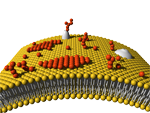Carbohydrate-carbohydrate interactions
What are carbohydrate-carbohydrate interactions (CCIs)?

Carbohydrates ubiquitously exist as components of glycoproteins and glycolipids on cell surfaces and play substantial roles in various molecular recognition events including fertilizations, differentiations and cell-cell adhesions. These carbohydrates have been recognized so far as ligands for carbohydrate recognition proteins, such as lectins. An increasing interest has been, however, placed on carbohydrate-carbohydrate interactions (CCIs) on cell surfaces, in which carbohydrates recognize carbohydrates in specific manners. Glycosphingolipids (GSLs) on cell surfaces aggregate laterally to form micro domains to present densely packed carbohydrate clusters. Face-to-face interactions between such carbohydrate clusters from neighboring cells are the very first and an essential step in various cellular recognition events including compactions of embryos, cancer metastases and inflammations. It is of quite interest that these micro domains are associated with various signal transferring proteins, such as c-Src, FAK, Rho A, etc. Since this fact strongly implies that these micro domains play important roles not only in cell-cell adhesions but also in cell-cell signal transductions, these micro domains are now widely called "carbohydrate signaling domains". Investigation on CCIs is of quite attractive, since it should supply useful information not only to understand mechanism of the cell-cell adhesions and the signal transductions but also to design new drugs to prevent various diseases triggered by unfavorable cell-cell adhesions (cancer metastases, inflammations, etc.). In spite of such importance, heterogeneity and fluidity of the cell membranes make it quite difficult to investigate CCIs in a detailed and quantitative manner.
Artificial model systems to probe CCIs
Simple and well-designed model systems are, therefore, highly required to obtain molecular-level information on CCIs. Strength of CCIs also adds to the problem; that is, CCIs between two isolated carbohydrates are so weak that they are hardly detectable. Multivalent interactions between the clustered carbohydrates are, therefore, adopted in nature to overcome this problem. Most artificial systems also utilize densely packed carbohydrate clusters to probe CCIs. For example, interactions between Langmuir monolayers composed of GM3 and dendrimers presenting multiple β-lactosides has been investigated by using π-A isotherm. It has been also reported that aggregations of gold nanoparticles immobilized with LeX-trisaccharides were induced by calcium ion in a specific manner.
Our approaches to access molecular information on CCIs
The aforementioned works successfully demonstrated specific CCIs between two carbohydrate clusters immobilized with the polymeric scaffolds and/or the gold surfaces. Only limited information has been, however, obtained so far on contributions of each monosaccharide unit in these oligosaccharides. It should be noted that these works are categorized into intermolecular approach. Since intermolecular bindings between two carbohydrate molecules accompany large entropic lose, so the multivalent interactions between the carbohydrate clusters are essential for these systems to probe CCIs. Almost no molecular-level information, such as spatial packings of the carbohydrates and stoichiometries between the carbohydrates and calcium cations, has been, therefore, obtained to date suffering from the huge numbers of carbohydrates in these systems. The other approach to investigate CCIs is intramolecular one. Since CCIs between two carbohydrates linked together with an appropriate spacer can minimize the entropic lose on their bindings, numbers of carbohydrates to induce their bindings can be also reduced in this approach. We have been pursuing the intramolecular approach to investigate CCIs by using various model systems. One advantageous feature of our systems relies on their scaffolds; that is, scaffolds of our systems are designed to function as chromophores to monitor CCIs-induced conformational changes based on their UV-vis and/or CD spectra.
